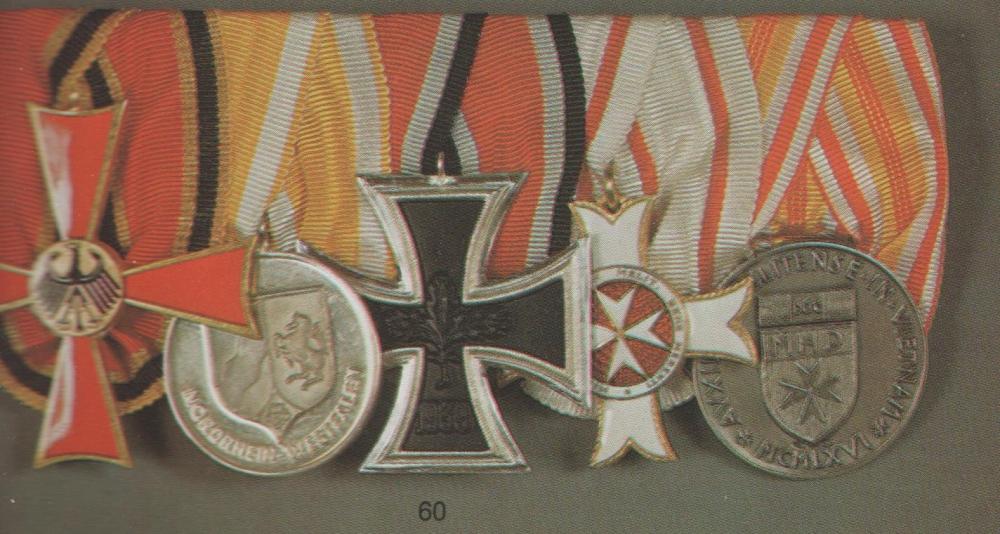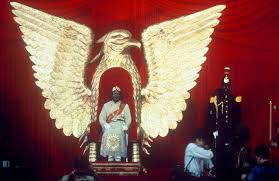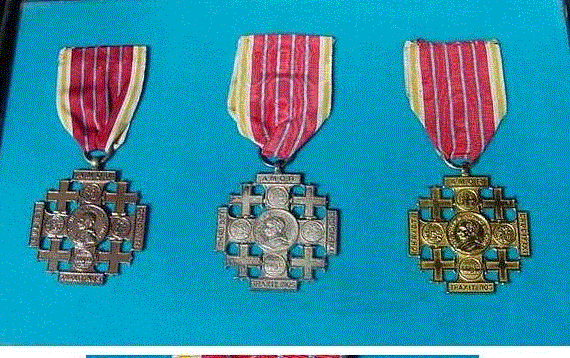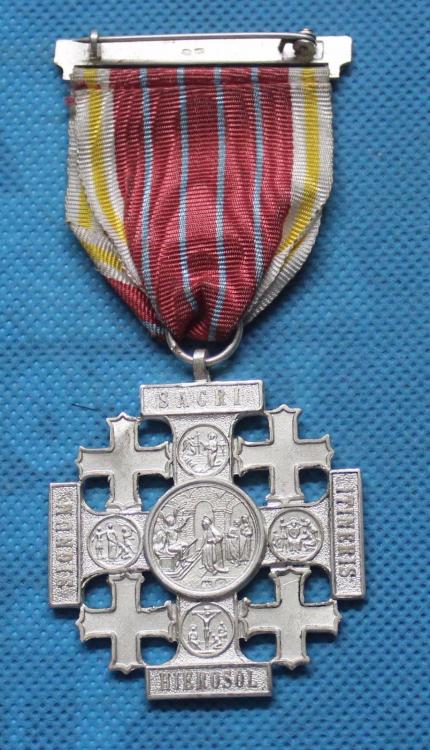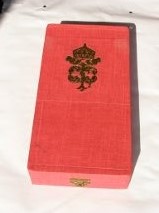
922F
Patron-
Posts
1,384 -
Joined
-
Last visited
-
Days Won
7
Content Type
Profiles
Forums
Blogs
Gallery
Events
Store
Everything posted by 922F
-
Cockroach, rat, grasser, [a more positive slant--confidential informat], generally negative depressive term!!
-
Are these images of the same piece? If not, then two examples with what looks like the same damage/bend to flag tip filials? First posted item apparently has a [replacement] piece of wire rather than a pin holding medal planchet to crown & flags suspension. Bertrand made these so there may be a French silver fineness mark, and perhaps Bertrand's mark, most likely on the ribbon suspension bar. Does this piece have any such marks? Lame gives ribbon color as red others as green. Several years ago, rumors of cast Zogist Triumph of Legitimacy medals circulated; these supposedly had moulding/casting marks around edges, no ribbons and no silver fineness or maker's marks. Based on that, I would carefully examine the item before considering purchase.
-
Seem to recall that sometime ago a member sought an image of the Sovereign Order of St. John of Jerusalem's Medal for relief activities in Vietnam. I do not recall who posed the question or whether it found a reply. An image from Kirchner & Truszczynski's Ordensinsignien und Auszeichnungen des Souveranen Maltese-Ritterordens, published in 1974, shows a group with this medal in last place. You will find it below under 'fair use' precepts. The work had no additional information about this medal.
-
Star body looks [completely?] very similar to Georgian Tamara Order!!! Note especially obverse star ray 'dish or hollow' format, ray 'flattening' at reverse perimeter & reverse junction between rays and center......
-
73 YEARS SINCE KING BORIS III DEATH
922F replied to Graf's topic in Central & Eastern European States
Simply spectacular Alex!!!! Really first rate image! Thank you for another outstanding piece of art! N.B. The award that I saw did not have brilliants. -
73 YEARS SINCE KING BORIS III DEATH
922F replied to Graf's topic in Central & Eastern European States
Graf--You may have a point. However, notice that the individual rays on mid-late Boris emission Merit stars you posted are distinctly spaced [space in between rays], most noticeable at the extremities. Merit star facets diminish in size/diameter as they approach the star center. The XX 'star' exhibits neither of these characteristics. XX star rays abut each other. Facets appear smaller than those on the others and very uniform in size from center to extremities. So perhaps Alex's XX 'star' image is the jewel set ‘star’? By the way, do you believe that the 1936 date is accurate for introduction of diamond-cut rays for Boris type Merit Order stars? -
73 YEARS SINCE KING BORIS III DEATH
922F replied to Graf's topic in Central & Eastern European States
Alex raised the officer long service awards [‘stars’] given to Boris question in a GMIC post titled "unknown Order” on March 31, 2014. That discussion addresses most points/issues but is not conclusive due to the lack of authoritative references. Alex’s 2014 post includes a colorized composite image of a XX ‘star’ and an actual image of the X ‘star’. I personally know of only 1 example of the X year ‘star’ [displayed in Sofia’s National Museum of Military History, at least in 2008]. While visiting the award collection of Ferdinand and Boris at Simeon’s Madrid residence in 1972-3, I saw one XX year ‘star’. Colonel Guetichev, one of Simeon’s aides who guided my visits, commented that two or three XX examples existed at one time, likely for use on different uniforms including one for a naval uniform. He or another staff member said that Ferdinand gave Boris a brilliant set XX ‘star’ probably made by Zimmerman but that’s the only time that I heard that story. [I failed to inquire about the X ‘star’ as I did not know it existed then!] As noted above, perhaps in reaction to his father’s predilections, Boris seldom wore many decorations and when he did the most usually seen stars were the Cyril & Methodius and the XX ‘star’. -
Pieter, The Bertrand-Bokassa relationship in fact spawned much more than lucrative 'medals' contracts. Following Bokassa's overthrow, many French press articles excoriated Bertrand's alleged 'medals for diamonds' greed. Bertrand supplied almost all imperial regalia [including crowns, sceptres plus things like a large imperial eagle starburst insignia still perched over the defunct entry to Bokassa's 'palace' complex inBerengo], got a contract for 'merchandizing' supplies for the Imperial Court, reportedly including things from champagne to school uniform thread, and subcontracting manufacture of the THRONE!! All at 'competitive pricing!!!'
-
Ilja's post 52 above 'deconstruct' appears to be a Bichay origin star of likely late 1960's vintage. Bichay made this insignia from the late 1950's-early 1960's up until the early 1980's, I believe. Sometimes one finds Egyptian silver fineness marks on the primary and secondary star bursts, the 'ring' of stars, the reverse rondel bearing Bichay's name in Arabic , and the suspension ring for such pieces. Not sure if Ilja's has these. Some Egyptian silver export items do not have fineness marks.
-
Yes, New World, Spink both sold awards to collectors and manufactured national, regional and private decorations. At one time years ago, Spink supplied insignia for most Commonwealth states, other former British possession/protectorate nations and many aligned/allied countries. J. Jacob's Court Jewellers of the World [1978] outlines Spink manufacturing activity. I believe the firm retailed awards for collectors from ca. 1899 until, as Paul said above, about 2009-11.
-
Thank you, my pleasure, I omitted images of the Cross so here are examples of all 3 grades. Also, a 2nd class [silver] with 'Jerusalem' bar and reverse of same:
-
Post 48--Excellent find, New World!!! Have seen very few of these in 40 years and one may have been the same piece in a different collection!!! And none for me....... Please, is the reverse with maker mark and what kind of pin? Rough translation of Igor's post 25 concerning Mr. Janko Stefanov Kesarovski's gift of insignia and matrixs/dies to the National History Museum, section about the Red Cross 1892 Ferdinand type. "Complete set [of dies] for stamping/punching the "Red Cross" insignia [metal parts] - Ferdinand princely issue of 1892. Its dimensions are larger than the known specimens being 44 by 30 mm. Probably [only] a limited number of examples made for dignitaries. This type not published in references. No known miniatures of this type."
-
ÖSTA may be correct in citing 'University of Wikipedia' comment on Pilgrim's Cross continuance. First, here's my reply to GMIC post "Ribbon bar with unknown ribbon - Turkish? Started by webr55, November 29, 2007" Our dear friend Rick Research identified the 'unknown ribbon' as representing the Holy Land Pilgrim's Cross. December 1, 2007 about 10 a.m. GMT As Rick notes, this Pilgrims' Cross existed in this form from 1901 through "reforms" of the 1980s. From the inception, the grade depended on the number of pilgrimages to the Holy Land or the amount of "DONATIONS" contributed. In 1975, for example, the gold class recognized ten or more visits, silver 5-9 and bronze 1-4. "Donations" at that time were US$5 for bronze, $25 for silver and $50 for gold (silver gilt)---don't see how insignia costs were paid at those prices, let alone a significant "donation". {Guess the numbers had not been adjusted for years somewhat like the Japanese Red Cross criteria!} Sometime in the 1930s the "Jerusalem" bar illustrated signified a "special" award (no specific number of visits or contribution amount) but following WW 2 that bar was also presented to non-Catholics granted the honor. Apparently due to misunderstandings on the part of the Italian insignia supplier, the bar accompanied just about ALL awards after about 1960. {Added 2016 -- Crosses made in France, Spain or Austria usually do not have the bar.} Because the award was presented under delegated authority of the "Custos" of the Holy Places or Latin Patriarch of Jerusalem--usually a Dominican also involved in the Papal Order of the Holy Sepulchre, French awardees, among others, could not apply for permission to wear it until the post WW II 4th republic. December 1, 2007 about 3 p.m. GMT Rick shamed me into digging into Peter Bander van Duren's 1985 revision of Cardinale's, Orders of Knighthood, Awards and the Holy See. Pp 111-112 fully describes the cross and notes that it is an award instituted by the Papacy but not conferred by the Holy See, as bestowal was delegated to the Custos of the Holy Land. "These marks of distinction cannot therefore be qualified as pontifical." However, van Duren's 1987 work, The Cross on the Sword , states [p. 139 & 156-7] that the Holy Land Pilgrim's Cross was replaced with two new awards around 1977. {N.B. I have seen a Pilgrim's Cross document dated 1981} These are the Palm of Jerusalem [conferred by the Grand Master of the Order of the Holy Sepulchre of Jerusalem in 3 classes for 'special services or charitable work towards the Order'] and the Pilgrim's Shell [awarded by the Latin Patriarch of Jerusalem (CUSTOS) and the Grand Prior of Order of the Holy Sepulchre of Jerusalem on behalf of the Grand Master to members of the Order who make a pilgrimage to Jerusalem]. Unless there are subsequent changes, the Palm of Jerusalem award is mainly for, and the Pilgrim's Shell exclusively for, members of the Order of the Holy Sepulchre of Jerusalem. Within the past day, I learned of a document for a Holy Land Pilgrim's Cross, in bronze, dated July 2001! While van Duren cites only a general regulation regarding distinctions [which I cannot locate], perhaps he is wrong in stating that the Palm and Shell awards replaced this decoration. While it may be possible that someone simply 'completed' blanko bestowal documents and dated them in 1981 and 2001, http://www.custodia.org/default.asp?id=1163 seems to indicate that the cross continues to be available. I sent an inquiry to the Custos' office to confirm this and will share the response. I asked about the 'Jerusalem" bar significance as well.
-
Concerning earlier posts asking about Hungarian Order of Merit insignia manufacturers, Vienna firms had branches in Budapest as early as the 1880's [Jacob lists Schied & Tiller; others cite a Rothe subcontractor or sales office]. Hungarian insignia makers 1914-1941 include Jerouschek and Morzami of Budapest plus Maurer of Sopron. German sources [Klietmann et al.] usually attribute Regency medals to the State Mint or German contractors. While these may be potential Order of Merit insignia production candidates, no firm evidence confirming such activity exists to my knowledge. Never saw any maker stamp in any Hungarian Regency award case though these almost always appear beautifully made. At least 2 Hungarian language books, one focusing on the Regency period and one a general history up to 1992, describe this Order's variants and may well identify the manufacturer. Unfortunately, I cannot read Hungarian! An image of the cover of one general book, written by Kenyeres Denes, published 2004, follows. Perhaps a Hungarian GMIC member could elucidate?
-
Happy to see first type medal!!
-
According to Cardinale, the Vatican abolished the Jerusalem Pilgrim's Cross [position 5 above] in 1977.
-
A superb miniature Burma Campaign 1826
922F replied to paul wood's topic in Great Britain: Orders, Gallantry, Campaign Medals
Magnificent!! -
Bulgaria FAKE BULGARIAN ORDERS ON THE MARKET
922F replied to Graf's topic in Central & Eastern European States
Graf--is it correct to state that the distinguishing features for the fake Order for Bravery Star 1st Class are the design element of the sword grips [stippled and knurled detail] and the reverse central boss/protuberance? Is the round 'shiney' area discoloration from a label or a different piece of metal? Is the center enamel soft? Thank you!! Somewhere [maybe in a 1970s Klenau auction--will attempt to find?] I saw a 1st Class Order for Bravery Star with BOTH sword grips knurled. At one point Victor had a star with 'diamonds' set in the ring around the motto. -
Please help to identify royalties and high-ranking officers
922F replied to Freiwillige's topic in Austro-Hungarian Empire
Is the civil servant wearing a Bavarian Crown star on his left? Great image of Starry Cross, lady face obscured by King Ludvig III. -
This seems to be a 'mule' comprised of an apparent Bertrand-made Order of the Sun of Peru corpus and a Togo Order of Mono center and ribbon. [Opine Bertrand origin based on suspension wreath shape & enamel work.] Several dealers sell what may be over-production or surplus parts that must trickle out of manufacturers' or sub-contrators' stocks. Sometimes these appear on European eBay sites put together as 'mules' and sometimes only 'spare parts', usually center medallions and sometimes badge corpi, if that's the term. A while back, for example, Romanian Star Order knight grade crosses without centers or suspensions emerged in lots of 5 or more. Sometimes these are sold as 'trial pieces' and sometimes as 'independent orders' insignia. Of course, there's a remote possibility that it could be a new design for a Togo Order not yet reported anywhere!
-
Bulgaria FAKE BULGARIAN ORDERS ON THE MARKET
922F replied to Graf's topic in Central & Eastern European States
Regarding Paul's post 51 above, so far I know of only very crude box/document forgeries. New World's post 36 in this thread depicts one [the major?] type of fake cases or boxes of issue. Cassia/Victor & others also offered Grand Cross, First Class and Grand Officer sets in newly made red boxes with either just a sloppily applied gilt Ferdinand cypher on the outer lid [image below] or that same cypher die above the name of the Order. These usually had a poorly sized round insert in the case bottom pad for stars. A couple of original Grand Cross and Commander boxes with crudely replaced 'pads/nests' for insignia or inner lid liners are around too -- these would not fool most collectors. In Sofia 1996-7 [economic collapse years], blanko republic St. Alexander and Military Merit Order documents could be bought cheaply—5-10 U.S.$ or 10-15 DM. These not seen after about 1998. I recall seeing only 2 or 3 republic St. Alexander documents that appeared to have been blankos subsequently completed. These had the same 1946 dates seen on documents given to Red Army personnel but the personal info and rank were typed rather than in script. Whoever typed them had a heavy hand as parts of characters like я, д or а almost punched the document stock. -
Order of the White Eagle replica/copy?
922F replied to Tara's topic in Southern European & Balkan States
Recall many ladies wearing Serb/Yugoslav White Eagle full size insignia in the 1960's-70's "Because it looks so nice" or "It came down through the family." Usually these were knight, officer or commander badges worn suspended from a chain around their necks. One time, though, a Grand Cross star [civil] worn pinned as a stole fastener!! [not even mink!!] When informed what these pieces actually represented and signified, "Oh no, it's Polish" or "Not true, a Paris creation!" Suppose these replies due to ignorance or the 1950's-60's availability of Coro 'jewelery'! One lady took me seriously and removed her 'necklace.' I recall similar stories from people like S.G. Yasinitsky involving Imperial Russian awards and George Dimacopoulos regarding Greek Order of the Redeemer pieces. And...Michael Jackson's White Eagle commander?? Seems an extremely remote possibility this item originally belonged to a female holder of the Order with swords--but, perhaps, practically anything is possible. I'd opine that it was converted as a piece of 'found art' into a stunning pin. I, contrary to other contributers, would attempt to remove the pin by the most simple means--heat the pin with a soldering iron myself or ask a jeweler to do it. That should melt the solder and release the pin. If that method failed, leave it as it is because epoxy [the next most likely 'fastener'] is nearly impossible to remove without solvents that could damage enamel. -
Bulgaria FAKE BULGARIAN ORDERS ON THE MARKET
922F replied to Graf's topic in Central & Eastern European States
Thank you, I found it and agree with you. Maybe for 100 euro.... -
Bulgaria FAKE BULGARIAN ORDERS ON THE MARKET
922F replied to Graf's topic in Central & Eastern European States
Hello Graf, Has this star been removed from eBay? I cannot find it. Your defect notes seem correct especially rough finish, motto letters, star burst cut details and so on. It appears that the Schwerdtner plaque is not similar to usual ones. I believe that you know the differences. If not, please send me a PM [do not want to list them here]. What about ebayde 131937236792? Wrong color motto ring, black edges...... -
Judging by apparent size -- 75-80 mm.? [compare with St. Alex sash badge likely size] and suspension ring, this possibly first class Civil Merit badge may have white enamel replaced with brilliants. Case appears original velvet covered type, perhaps by Rothe, usually associated with jewelled pieces.


